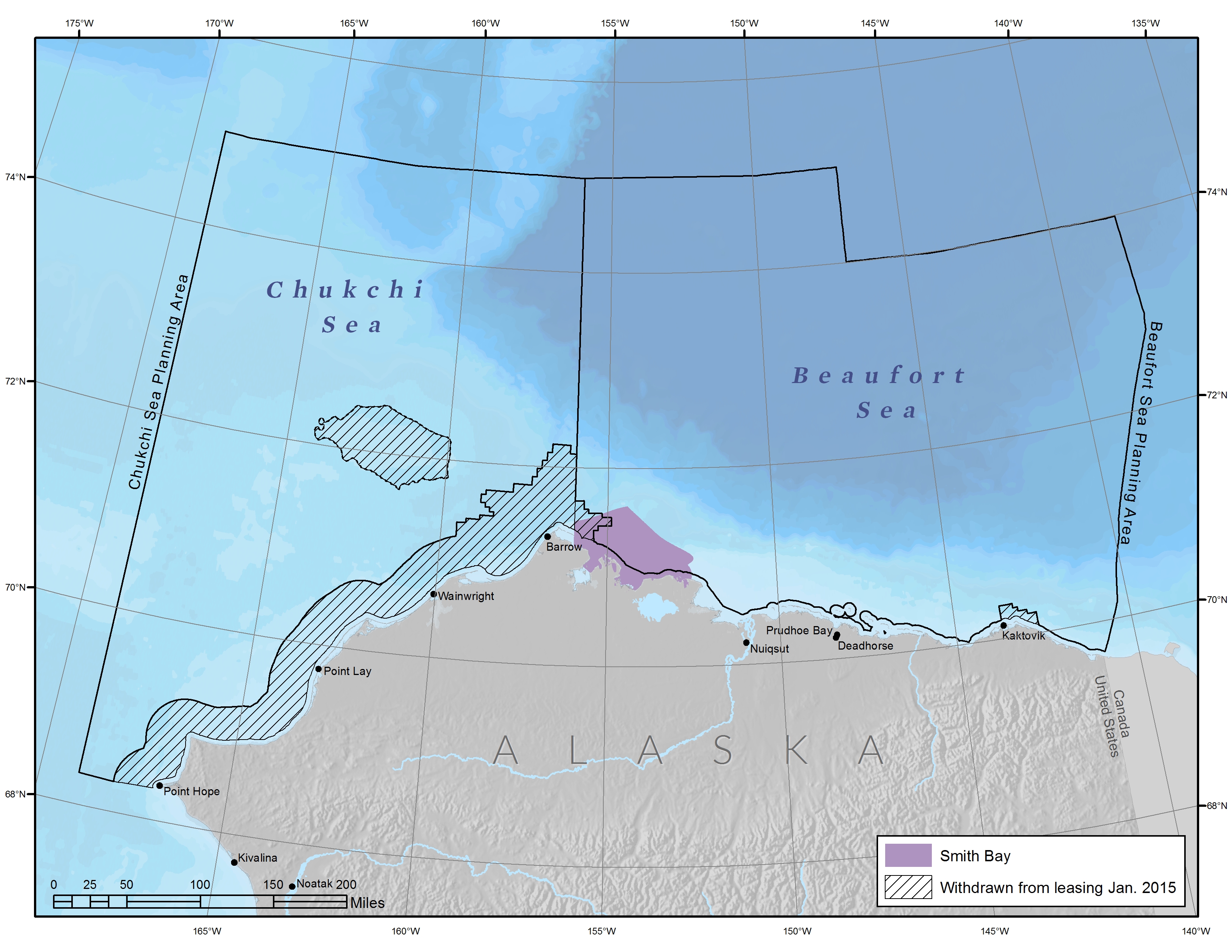Smith Bay on:
[Wikipedia]
[Google]
[Amazon]
Smith Bay is an 
What We Can Learn From Remarkable Smith Bay
{{coord, 70.88, -154.30, type:waterbody_region:US-AK_dim:100000, display=title Bays of Alaska
estuary
An estuary is a partially enclosed coastal body of brackish water with one or more rivers or streams flowing into it, and with a free connection to the open sea. Estuaries form a transition zone between river environments and maritime environm ...
in the Beaufort Sea that supports a wide range of fish, birds, and marine mammals. It is located northeast of Point Barrow, Alaska. The Bureau of Ocean Energy Management
The Bureau of Ocean Energy Management (BOEM) is an agency within the United States Department of the Interior, established in 2010 by Secretarial Order.
The Outer Continental Shelf Lands Act (OCSLA) states: "...the outer Continental Shelf is a v ...
recognizes the southeastern portion of Barrow Canyon, which covers some, but not all, of Smith Bay, as an Environmentally Important Area. 
Geography
Approximately 150 miles west ofPrudhoe Bay, Alaska
Prudhoe Bay is a census-designated place (CDP) located in North Slope Borough in the U.S. state of Alaska. As of the 2010 census, the population of the CDP was 2,174 people, up from just five residents in the 2000 census; however, at any give ...
, Smith Bay stretches from Dease Inlet, Alaska to Cape Halkett, Alaska. Bordered by barrier island
Barrier islands are coastal landforms and a type of dune system that are exceptionally flat or lumpy areas of sand that form by wave and tidal action parallel to the mainland coast. They usually occur in chains, consisting of anything from ...
s that separate the shallow, brackish
Brackish water, sometimes termed brack water, is water occurring in a natural environment that has more salinity than freshwater, but not as much as seawater. It may result from mixing seawater (salt water) and fresh water together, as in estu ...
waters from the Beaufort Sea, several slow-moving rivers flow into this region. Along with its adjacent waters, Smith Bay is a shallow-water estuary.
Fauna
Smith Bay is a significant hotspot forpinnipeds
Pinnipeds (pronounced ), commonly known as seals, are a widely distributed and diverse clade of carnivorous, fin-footed, semiaquatic, mostly marine mammals. They comprise the extant families Odobenidae (whose only living member is the walru ...
. The nearshore areas are important habitat for ringed seal
The ringed seal (''Pusa hispida'') is an earless seal inhabiting the Arctic and sub-Arctic regions. The ringed seal is a relatively small seal, rarely greater than 1.5 m in length, with a distinctive patterning of dark spots surrounded by light ...
s that come to the landfast ice during the winter and spring to give birth.
Polar bears and bowhead whales rely on Smith Bay for important foraging habitat. Polar bears have been observed using Smith Bay as a major maternal denning area to raise their young.
Many species of birds, including yellow-billed loon
The yellow-billed loon (''Gavia adamsii''), also known as the white-billed diver, is the largest member of the loon or diver family. Breeding adults have a black head, white underparts and chequered black-and-white mantle. Non-breeding plumage is ...
s, king eider
The king eider (pronounced ) (''Somateria spectabilis'') is a large sea duck that breeds along Northern Hemisphere Arctic coasts of northeast Europe, North America and Asia. The birds spend most of the year in coastal marine ecosystems at high la ...
s, Arctic terns, black-legged kittiwakes, glaucous and Sabine's gulls, king eider
The king eider (pronounced ) (''Somateria spectabilis'') is a large sea duck that breeds along Northern Hemisphere Arctic coasts of northeast Europe, North America and Asia. The birds spend most of the year in coastal marine ecosystems at high la ...
s, long-tailed duck
The long-tailed duck (''Clangula hyemalis''), formerly known as oldsquaw, is a medium-sized sea duck that breeds in the tundra and taiga regions of the arctic and winters along the northern coastlines of the Atlantic and Pacific Oceans. It is th ...
s, and red phalaropes, are found in Smith Bay.
Oil discovery
There is a knownoil seep
A petroleum seep is a place where natural liquid or gaseous hydrocarbons escape to the earth's atmosphere and surface, normally under low pressure or flow. Seeps generally occur above either terrestrial or offshore petroleum accumulation stru ...
at Cape Simpson on the western side of Smith Bay. In 2015 and 2016, Caelus Energy Alaska drilled two exploration wells in the southern part of the bay. In October 2016, the company announced what it called a major oil discovery in the bay and said it would drill a third well in January 2018 and proceed with permitting a pipeline afterwards. A pipeline under the Chukchi Sea or a pipeline on land close to "Qupaluk" (“small bird” in the Inupiaq language) would be required, threatening the habitat of at least 30,000 migratory birds.
References
Further reading
What We Can Learn From Remarkable Smith Bay
{{coord, 70.88, -154.30, type:waterbody_region:US-AK_dim:100000, display=title Bays of Alaska